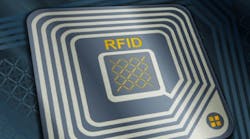>> Website Resources
.. >> Library: TechXchange
.. .. >> TechXchange: Power Management
.. .. .. >> Topic: Energy Harvesting
Radio frequency identification (RFID) is usually implemented with a reader and tag containing an integrated circuit (IC). The wireless technology provides reliable and accurate identification of tagged people, animals, and objects, but is relatively expensive compared to bar-code readers as an electronic identification method. To encourage greater use of RFID wireless technology, researchers at Universite Grenoble Alpes, Le Laboratoire de Conception et d’Integration des Systemes (Valence, France) have developed a chipless RFID system (without ICs) using ultrawideband (UWB) signals.
The researchers refer to an early chipless RFID system in which an RFID tag with multiple antennas served as the target for a transceiver capable of radar imaging techniques. They point out updated chipless RFID designs based on readers working with UWB signals.
Rather than many antennas, the modern chipless RFID tags present a unique circuit pattern on a printed-circuit board (PCB) to the RFID reader. The pattern is formed with the copper conductor of a circuit laminate material. The RFID reader transmits low-power, wideband signals into an area to read the tag, measuring and analyzing backscattered signals from the tag to obtain information about it according to what is coded by the circuit pattern. This UWB approach is not compatible with traditional RFID systems, which use narrowband signals, and must conform to federal agency regulations regarding the use of unlicensed transmissions within the 3.1- to 10.6-GHz UWB frequency range.
The researchers present examples of time- and frequency-domain chipless RFID tags with the simplest possible circuit designs. The time-domain RFID tag consists of a single antenna and transmission line fabricated on the PCB. By using impedance mismatches at different locations along the transmission line, the tag can be coded to present a unique reflected signal to the reader. In the frequency-domain chipless RFID tag, two UWB antennas are used with a passive filter between them to create a unique reflected signal.
Time-domain RFID readers transmit short pulses toward an RFID and measure the backscattered signals. Frequency-domain RFID readers transmit continuous-wave (CW) signals, either in stepped-frequency CW (SFCW) or frequency-modulated CW (FMCW) formats, to produce backscattered signals for analysis.
The two chipless RFID reader approaches differ in performance in terms of key parameters, such as read range and read time. However, the researchers note that RFID readers have been designed to identify both time- and frequency-domain chipless RFID tags for flexibility and extended coverage, making this a promising and cost-effective wireless solution for identification purposes.
See “Ultrawideband Chipless RFID,” IEEE Microwave Magazine, June 2019, pp. 74-88.
>> Website Resources
.. >> Library: TechXchange
.. .. >> TechXchange: Power Management
.. .. .. >> Topic: Energy Harvesting

